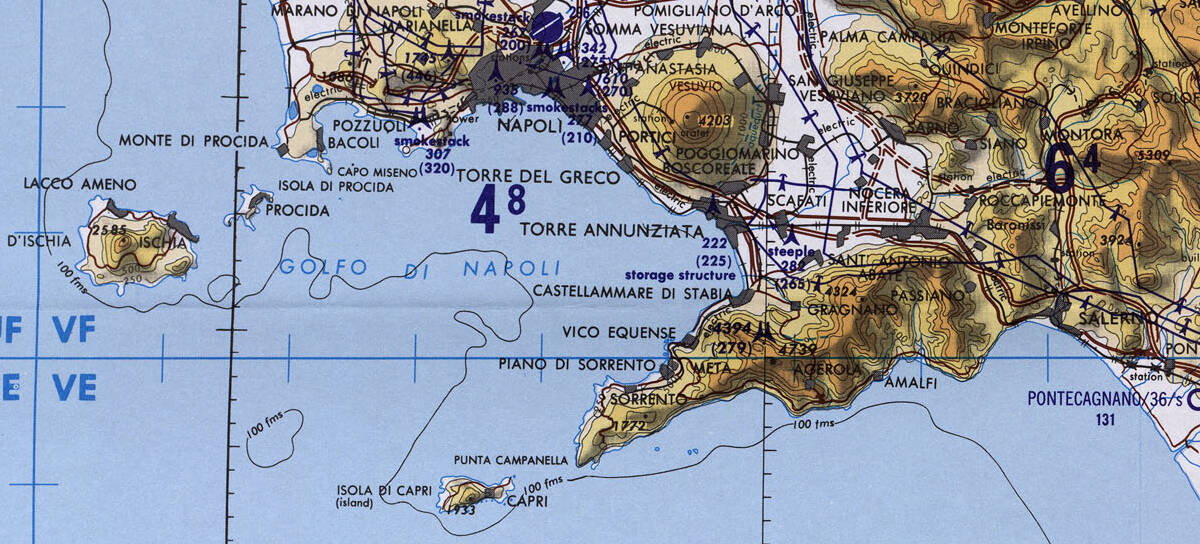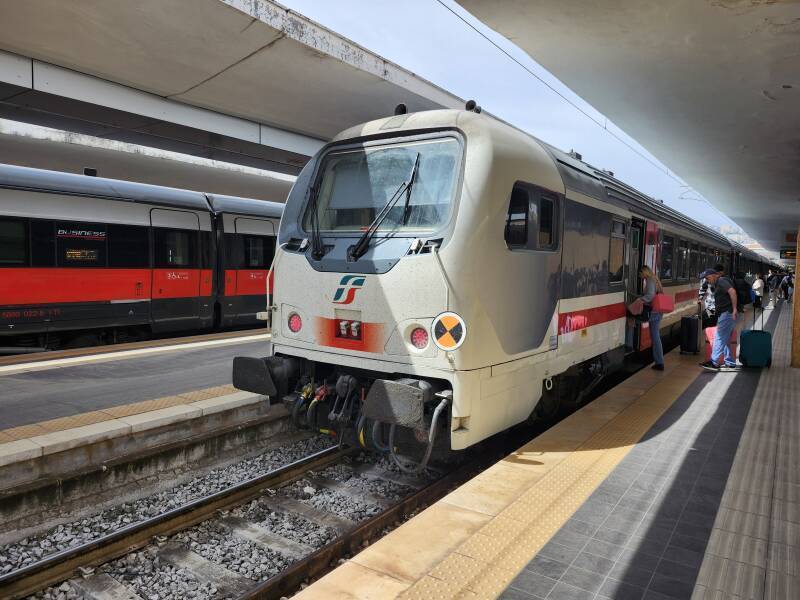
Salerno
Visiting Salerno
Visiting Pompeii Flânerie, the art of being a flâneur
I had been staying in Napoli and had visited Pompeii,
and now I was heading a short distance south to Salerno.
It's on the other side of the Sorrento Peninsula
from Pompeii, Vesuvius, and Napoli.
Rugged terrain lies between the two cities.
While staying in Salerno, I made a day trip to Paestum.
The historic center of Salerno is a nice place to wander
aimlessly,
looking at the buildings and being a flâneur.
Which, in Italian, seems to be passeggino.

Portion of aeronautical chart TPC F-2C, from the Perry-Castañeda Library Map Collection at the University of Texas at Austin. Salerno is along the coast near the left edge.
Going to Salerno
Trainsin Italy
I took an older train from Napoli Centrale to Salerno. It was an InterCity, the ones that make the long but non-high-speed trips, some of them overnight with couchettes and private compartments.


Finding My Lodging
From the Salerno station it was about a twenty-minute walk along the waterfront to the area where my lodging was.
Guesthouses at Booking.comI was looking for my guesthouse at Via Arechi 17. I had made my reservation through Booking.com and it was the new model frequently encountered since COVID-19 hit. It's a small apartment in a building with many apartments being rented out this way, and I didn't see or directly interact with my innkeeper at all. In Salerno, I coordinated my arrival time to meet the cleaning lady and get the key from her.
Off the waterfront avenue into this narrow passageway.


The passageway opened into a small square. Across the square and to the left is A'Corte, an excellent taverna.
My lodging was to my left. Back this first passageway then turn right:


Yes, some tiny cars move through these narrow passageways. Be ready to step into a doorway to give one room to pass.
The door I'm looking for is the one with the yellow and green recycling bins next to it. The first key opens the small door within the large door.


That led to an open area within the building. Multiple locked doors open into stairwells. Use the second key on the correct stairwell door.


Then the third key lets you into the apartment. It started with an entryway with a mini-fridge and coffee machine.


Then there was the bedroom and the bathroom.



Along the Waterfront in the Evening
As soon as I got settled in, some rain came through. I went out later and strolled around the area.

People have lived here since Neolithic times. The Etruscans founded their city Irnthi here in the 6th century BCE. That was replaced by the Roman colony of Salernum in 197 BCE. The area was controlled by the Byzantines through 553–568. Then the Lombards invaded, eventually making this part of the Duchy of Benevento.


Arechi Castle overlooks Salerno from about 360 meters above the waterline. It was started in the 6th century CE, over the remains of an old Roman fortress. What you see today was built by dukes of Benevento. Arechis II of Benevento transferred the seat of government to Salerno in 774 CE, making further improvements to the castle.

Wandering the Centro Storico
First, the standard breakfast to prepare for flânerie — cornetto e doppio caffè or a croissant and double coffee.

Real coffee, espresso, what Italians mean when they ask for "coffee".


The streets are narrow in the storico centro, the historic center. A farmacia and a tabacchi, a typical Italian street scene.


Deaths and funerals in Italy are announced by small posters.

I was here during the time that Pope Leo XIV was being selected at the Vatican. There had been a controversy about the bad kerning on the grave marker for his predecessor, Pope Francis. I would expect this firm to get it right.


Late afternoon begins the time for an aperitivo. An Aperol spritz is a common drink, and they bring a variety of snacks.

Aperol spritz is made with the bitter apéritif Aperol, Prosecco sparkling wine, and club soda.

Then, later, at least 7 but more likely 8 PM, dinner. This is spaghetti with mussels at A'Corte, just around a narrow building from where I was staying.


The meals in Italy are fantastic, but they can be just too much. The above pictures showed a breakfast and then a late dinner, and that could be plenty for the day.
Or, maybe I had a big lunch, and by 8 PM I still want nothing but an apertivo as dinner. Insalata caprese, buffalo mozzarella and tomato slices with basil, and an Aperol spritz.

I was again having dinner (or its replacement) very close to where I stayed. Through that arched doorway, the entry into my building was just two doors to the right.

The Waterfront
A waterfront avenue and palm-tree-covered park run for about a kilometer and a half past the historic center.

There are some impressive but ominous buildings in a very Brutalist style along the waterfront avenue. Maybe not a pure Brutalist style, maybe a mix of that with Art Deco. But, strongly Brutalist, and therefore very Fascist in appearance. Interesting to see, but nothing that ever motivated me to take a picture of it.
The E45 express highway runs past the city, part-way up the mountains.


The express highway runs across impressive arched bridges. The rail line is underground, running through a tunnel to the flat open farmland north of the Sorrento Peninsula.

The harbor handles many large ferries and cargo ships.

Huge container ships and car carriers come and go.

Allied forces landed along the beaches from Salerno south to Paestum starting on 9–10 September 1943 in Operation Avalanche, the first stage of the invasion of mainland Italy.

Salerno was the provisional government seat from 12 February to 17 July 1944. King Vittorio Emanuele III lived in a mansion on the edge of the city, and the provisional government was based here.

There's little to nothing to see of the Operation Avalanche landings. The Allied goal was Naples and its harbor. But that was just barely too far north for Allied air cover of the landings. There are smooth beaches from Salerno through Paestum, fifty kilometers to the south. Germany had not fortified the area as they had with Normandy, so today it's just fifty kilometers of beaches.



The large white-above-yellow ship is a Grimaldi Lines automobile carrier. It's maneuvering away from the pier.


And away it goes.


As it leaves, another enters the harbor.

The Duomo and its Relics
A cathedral is a church that is the seat of a bishop. A duomo in Italy is a prominent church that has the features of a cathedral although it may not currently be the seat of a bishop. The duomo of a city is "The Big Church", the most prominent one. It might be the cathedral, or maybe the cathedral is actually a different church, or maybe there isn't a cathedral in that city.
Salerno's duomo happens to be a cathedral. The Roman Catholic diocese of Salerno, thus needing a bishop and a cathedral, was established sometime in the 5th–7th centuries CE. The Church of Saint Mary of the Angels and Saint John the Baptist was here.
The cathedral you see today was started in 1076, under the rule of Robert Guiscard or Robert de Hauteville. He was a Norman adventurer whose older brothers had joined a revolt against Byzantine rule around 1040. Robert arrived in southern Italy in 1047 and began conquering territory. He became Count of Apulia and Calabria in 1057. Two years later, Pope Nicholas II gave Robert the titles of Duke of Apulia and Calabria and Lord of Sicily. Sicily was held by the Saracens, Arabs of the Fatimid Caliphate, so that was the Pope giving permission and support for the coming Norman invasion of Silicy.
The cathedral's construction started in 1076, and it was consecrated by Pope Gregory VII in 1084. Pope Gregory VII and the Holy Roman Emperor Henry IV had been arguing back and forth. Each declared that they were deposing the other in 1076. Gregory VII repeated his excommunication and deposition of Henry in 1080. Henry organized a synod that declared that Gregory VII was no longer Pope, replacing him with Clement III. Henry and his Pope seized Rome in 1084 and Gregory retreated into the Papal fortress of Castel Sant'Angelo. Gregory issued yet another excommunication of Henry.
Henry IV then really deposed Pope Gregory VII. Henry ensured that his supporter was formally enthroned as Pope Clement III in March 1084, and he in turn crowned Henry IV as Emperor. Gregory withdrew to the south, dying in Salerno in May 1085.

So, if the church was consecrated by Pope Gregory VII in 1084, this was at least during the time that Clement III was generally recognized as the current acting Pope, and maybe after Clement III had transitioned from Antipope to Pope. At least as far as the Holy Roman Emperor saw things.
Notice the dual cross bars, that means that this is the seat of an archbishop. It's now the Primatial Metropolitan Cathedral of Saint Mary of the Angels, Saint Matthew, and Saint Gregory VII.


The bell tower is of Arab-Norman design, and wouldn't look out of place in Marrakech or Fez.

Bones of a former archbishop are in one of the side chapels.


The archbishop's throne is in the central apse.


The mosaic in the left apse depicts John the Baptist baptizing Jesus. The original church here had been dedicated to Mary and John the Baptist.
The right apse contains the tomb of Pope Gregory VII.


His body is in a stone sarcophagus, but a wax effigy is on display.
The main sight is down below, in the crypt. The cathedral holds what are believed to be the bones of Matthew, disciple of Jesus and author of one of the Gospels.

Early church tradition held that the disciple Matthew personally wrote the Gospel attributed to him. Modern scholars say that it was written anonymously by a Jewish man in the late first century CE, although it might have incorporated a source written by the disciple in addition to the Gospel of Mark. The title's prefix Κατὰ Ματθαῖον or "According to Matthew" was added in the second century CE.
Early Christian theologians including Irenaeus (c.125–202 CE) and Clement of Alexandria (c.150–215 CE) wrote that Matthew preached the gospel to the Jewish community in Judea and then went to other countries. The early writers don't agree on one list of countries, but almost all mention Ethiopia.
Tradition says that Matthew was martyred in Ethiopia for angering King Hirtaco.


Placards outside and inside the church related the story: Matthew was martyred in Ethiopia and buried there, around 68 CE according to tradition. Somehow his body was dug up by Christian knights and carried to Britain for reburial. In 352, the knight Gavino from the city of Velia, down the coast from Salerno, dug up Matthew's body in Britain and took it home to Velia. It remained there for about four centuries, when Matthew appeared in the dreams of "a pious woman and her son", telling them where to dig him up. His relics then moved to Castle Velino, then in the 8th century to Rutino, and then Capaccio before finally arriving in Salerno on 6 May 954.


Stairs behind the altar lead down to the reliquary.

I was about to leave when a maintenance man warned me about water on the floor. Yes, I'll step around it. Then I saw something explaining what was going on.

This was the sixth of May, the anniversary of Matthew's relics arriving in Salerno. According to local belief, on 6 May and 20 September, "manna", a clear liquid, is emenated by Matthew's remains. The film of water on the floor is thought to be this manna. People were gathering for a service in which they would use sponges to collect moisture from the floor and transfer it into tubes. It would be used to moisten cotton balls that would be distributed to the sick.

Operation Avalanche
After the defeat of the Axis Powers in North Africa, the Allies disagreed as to the next step. Winston Churchill especially wanted an invasion of Italy, "the underbelly of Europe". However, General George Marshall and most American planners wanted to avoid all delay of the Normandy invasion.
When it became clear that the Normandy invasion could not happen until 1944, Operation Husky, the invasion of Sicily, was approved.
Operation Ladbroke, part of the Sicily landingsThe Allies landed on Sicily on 9–10 July 1943. Mussolini was dismissed from his post as Prime Minister on 12 July. By 17 August both the Italian and German militaries had retreated off Sicily onto the mainland.
The Allies first landed on the peninsula of Italy on 9 September 1943. The landings were along a 50-kilometer stretch of beaches, from Salerno south through Paestum. Napoli with its great harbor was a little further away, and Paestum through Salerno were just barely within range of Allied air cover. Plus, the broad beaches from Salerno through Paestum would make for much easier landings.

Map of the September 1943 landings from a U.S. Army history book via Wikipedia.
Unlike Normandy, there are no German fortifications to see today.

Map of the September 1943 landings from a U.S. Army history book via Wikipedia.

Map of the Fifth Army's beachhead around Salerno at 2400 on 11 September 1943, from a U.S. Army history book via Wikipedia.
Where Next In Italy?
( 🚧 = under construction )
In the late 1990s into the early 2000s I worked on a project to
scan cuneiform tablets
to archive and share 3-D data sets,
providing enhanced visualization to assist reading them.
Localized histogram equalization
to emphasize small-scale 3-D shapes in range maps, and so on.
I worked on the project with Gordon Young,
who was Purdue University's only professor
of archaeology.
Gordon was really smart,
he could read both Sumerian and Akkadian,
and at least some of other ancient languages
written in the cuneiform script.
He told me to go to Italy,
"The further south, the better."
Gordon was right.
Yes, you will very likely arrive in Rome,
but Italy has domestic flights and a fantastic train system
that runs overnight sleepers all the way to
Palermo and Siracusa, near the western and southern corners
of Sicily.
So, these pages are grouped into a south-first order,
as they should be.
